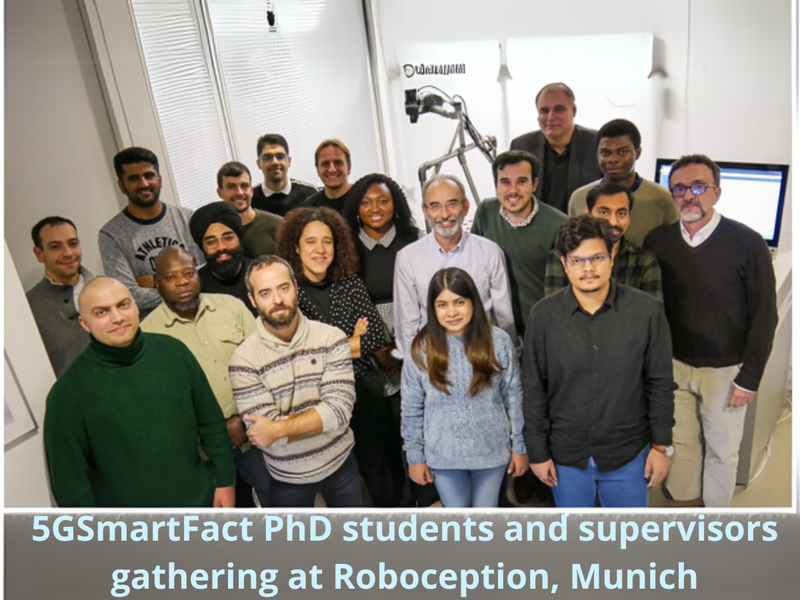5GSmartFact: addressing 5G evolution to support the future Industry4.0
11/03/2025
5GSmartFact: addressing 5G evolution to support the future Industry4.0
5GSmartFact is an MSCA-ITN project funded by the EU[1] whose objective is to work at the crossroads of factory automation and 5G evolution. We aim for a complete redesign of robot architectures that will lead to a leap forward in the industry automation
The project started in March 2021.
14 PhD students (early stage researchers - ESRs) were hired at the beginning of the project, with different kinds of background (robotics, telecom engineering, …) and complementary PhD projects related with wireless communications and robotics. ESR (upc.edu). 5GSmartFact ESRs spend at least half of their time working at one of the companies that make part of the 5GSmartFact consortium.
Dominik Urbaniak is one of the 5GSmartFact ESRs currently pursuing his doctoral studies at UPC. He investigates robotic applications for 5G. Collaborative robotics represents an interesting use case that aims at combining the strengths of human work force and robotics. However, there are not many places where robotic manipulators and private 5G networks are available. Following discussions with fellow ESRs from Aalborg University (AAU), Dominik got in touch with researchers that work in the AAU Smart Production Lab. They let him use their 5G network and robotic manipulator and performed distributed control experiments for collaborative robotics applications using the open source Robot Operating System (ROS 2).
In push and teleoperation experiments, images were sent at 60 Hz to the edge server which performed the image processing and sent back the object and hand poses to complete the closed-loop control. Parameters for QoS profiles, sensing rate, image resolution and compression were selected to reduce the reaction time of the robotic system in a shared environment with human workers. The results give an indication about suitable designs of collaborative systems that are productive and safe.
During his PhD, Dominik completed a 18-month secondment at Roboception, Germany, returning to UPC afterwards.
To know more:
Urbaniak, S. Bro Damsgaard, W. Zhang, J. Rosell, R. Suárez and M. Suppa, "Distributed Control for Collaborative Robotic Systems Using 5G Edge Computing," in IEEE Access, vol. 12, pp. 148706-148718, 2024, doi: 10.1109/ACCESS.2024.3475584.
Coordinator: Josep Vidal, UPC.
Consortium
5GSmartFact features a selected consortium of academia (Universitat Politècnica de Catalunya, Aalborg University), research centres (i2Cat, CNRS: Centre National pour la Recherche Scientifique), 5G companies (NEC, Nokia, Siradel) and expert companies in factory automation (ABB, Robert Bosch, Ingeniarius, Roboception), together with supporting institutions (Universidade de Coimbra, Université Paris-Saclay).
This Project has received funding from the European Union’s Horizon 2020 research and innovation programme under the Marie Sklodowska-Curie grant agreement No 956670
Project website
https://www.linkedin.com/company/itn-5gsmartfact
[1] This Project has received funding from the European Union’s Horizon 2020 research and innovation programme under the Marie Sklodowska-Curie grant agreement No 956670
Teleoperation experiment performed in the paper using 5G edge computing:



Small experiment with Roboception rc_visard and rc_cube using Ethernet as communication (not part of the published paper):



Comparteix: